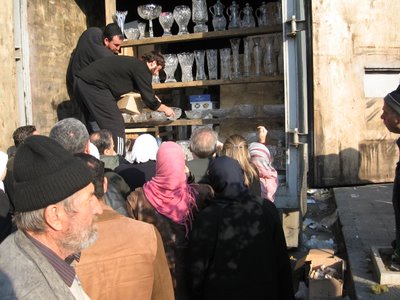hajjaj
 Since the spread of Islam centuries ago into southern Europe, the Caucuses and southern Russia, Damascus has served as a gathering place for pilgrims from these lands, as they travel to and from Mecca on the annual hajj.
Since the spread of Islam centuries ago into southern Europe, the Caucuses and southern Russia, Damascus has served as a gathering place for pilgrims from these lands, as they travel to and from Mecca on the annual hajj.This year is no different. The pilgrims congregate in a southern neighborhood called Zahira, which means, “radiant” or “shining,” parking their busses, trucks and campers – dozens of them – and set up a black market of goods from their homelands to sell and help pay for the journey.
Mostly from Russia, they sell fur hats, plastic jewelry, clothes and crystal, spreading out their wares on the sidewalks, or displaying them on shelves from the backs of trucks. In decades past, they would sell highly-coveted handmade carpets, but those have given way to brightly-colored, factory-made imitations.
Damascenes come to check the prices and, often, to buy.
These days, the hajjaj are parked in Damascus on their way home, having already performed the pilgrimage. Sleeping on their busses, they typically stay for a few weeks on the way down and sell their remaining goods on the way back. The other day, the Russian crystal was flying off the shelves.

<< Home